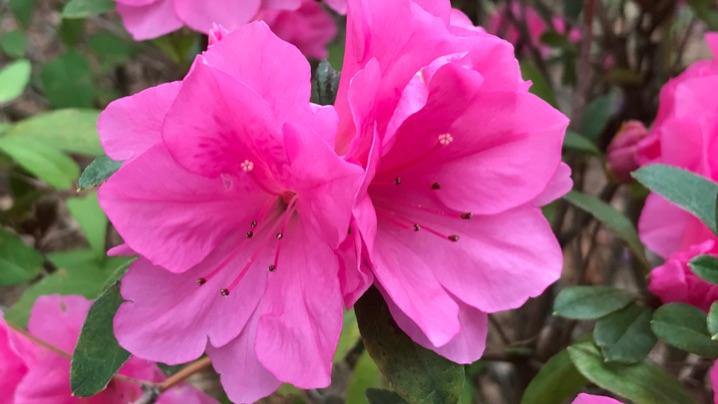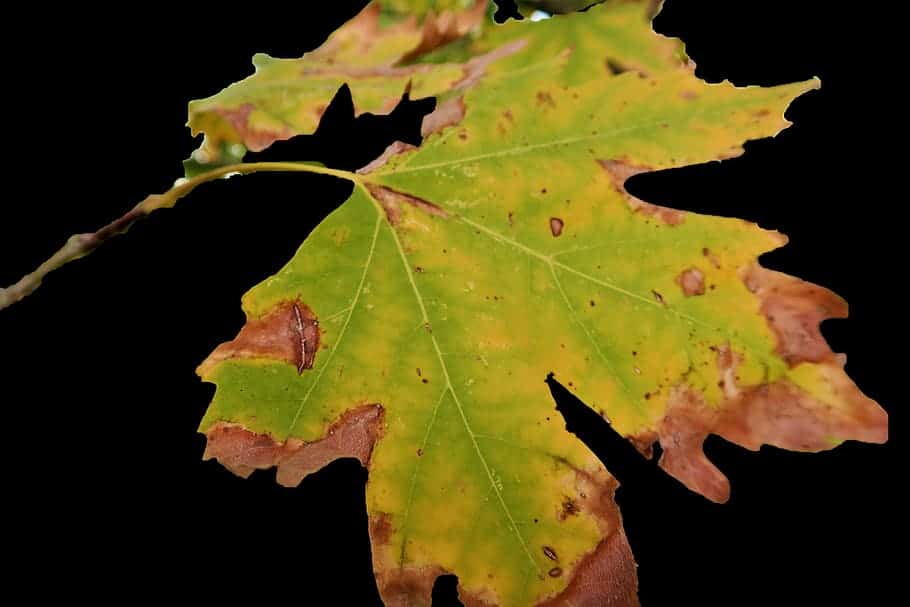Plant Azaleas in Your Garden: [Complete Guide and Answers]

the azaleait is a wonderful plant. Very typical to see in Japanese gardens, where it originates from.
It combines with many other beautiful or wild flowers and can also live for many years.
On the other hand, it can be considered an ornamental plant and also works as a houseplant.
Is there something wrong? Yes, it is somewhat delicate.
However, with this guide you will know everything you need to plant and grow your own azaleas for your garden or orchard.
Important points when planting azaleas
- When to sow? Preferably in early spring.

- Where? Outdoor sites, with semi-shade and good humidity are ideal for living. And in pots you also have to take care of the humidity of the substrate.
- Optimum temperature? Between 14ºC and 20ºC.
- Soil type? Non-alkaline, well-drained soils are ideal. The PH ranges between 5.5-6.
- How do we water? It needs permanent moisture, so it is recommended to use non-calcareous water permanently or it will get sick.
- How often do we water? You have to be generous, especially in summer. Water daily with elevated temperatures. Rest of the year, if there is no rain, once a week if the humidity of the environment remains.
- Plagues and diseases? Mites, various types of fungi, thrips, whitefly, red ant; worms.
When to plant azaleas?
 the azaleas, stunningly beautiful flowers are native to Japan. The months of splendor for planting are between March and May,time of beautiful spring season.
the azaleas, stunningly beautiful flowers are native to Japan. The months of splendor for planting are between March and May,time of beautiful spring season.
In the autumn-winter period, although the azalea blooms profusely, it must be protected in the house, away from sources of heat and direct light.
It can also be sown at the beginning of autumn, but the detail is that it will not be active in its most productive flowering period: winter.
Azalea seeds germinate in about a month, on a thin layer of sphagnum moss sieved over an acidic soil mixture. Needs aoptimum growth temperature between 8 to 16°C.
Where to plant azaleas?
Azaleas can grow in pots that are very well prepared to always keep the soil moist or in a garden where they receive indirect sunlight, sinceneed semi-shaded spacesor else its leaves will burn.
And it is that under natural conditions, azaleas grow in the high and humid part of the mountains, where they vegetate in areas near the course of rivers or springs, always looking for shady positions.
Did you know…In its natural habitat, it lives at altitudes higher than 4,000 meters in the mountains of Asia (Nepal, Japan, China, Vietnam and North Korea).
How do we prepare the land for growing azaleas?
It is not easy to keep this flower healthy. Actually, it is very delicate.
 But one ofthe keys lies in preparing a good substratewhen planting azaleas.
But one ofthe keys lies in preparing a good substratewhen planting azaleas.
The first thing to know about it is that they need an acidic substrate to prevent their leaves from turning yellow and the plant from dying.
So it is necessary to ask our trusted nursery or garden about the specific substrate for azaleas. Or buy an acidity corrector.
If we are going to keep it living in pots, the azaleas in this environment need a mixture of very well ventilated soft substrates, where the compounds of peat, perlite, pine needles and paramo soil are distributed in equal parts.
Why?Azaleas are very sensitive to the presence of calcium and magnesiumon the ground and its reaction is immediate: its leaves turn yellow, ugly, fall off and then the plant dies.
When the plants are kept outdoors, it is convenient to choose physiologically acidic fertilizers such as urea and sulphates, which must be supplied in the period from spring to autumn (April to September).
How do we water azaleas?
Azaleas need a lot of non-calcareous water.Therefore, the substrate must always be moist, which is not the same as waterlogged or soaked.
If we grow them in a pot, the saucer must always contain water and this is achieved by making a layer of well-moistened gravel.
The leaves must be sprayed with some frequency, with a product based on Thiophanate metyl that prevents the yellowish color in the leaves, produced by the effect of limestone in the water.
How do we plant azaleas step by step?
 Azaleas, although always delicate in their maintenance, are resistant plants that can grow in many places in the world.
Azaleas, although always delicate in their maintenance, are resistant plants that can grow in many places in the world.
When planting an azalea, the choice must be the best, adapted to the available space that we will have to take care of it.
There are two main varieties: native azaleas,which are those that grow between bushes and do not need further care.And the Asian azaleas,that do require more attention and grow in the form of bushes.
Asian azaleas, in turn, have two mostly known varieties.
These are: Kurume hybrids, deep red in color and maximum growth of about 3 feet. And the hybrids from South India: with magenta-pink or white colours, they grow very tall and reach the size of a door or window. They are very hardy but need to be pruned regularly.
Here in 7 Steps
In the following recommendations we can follow step by step, the ideal conditions to plant and care for azaleas:
- Well-draining soil: Azaleas require well-draining soil. A good trick is to dig a hole in your garden in the rainy season. If the water remains stagnant, it means that the soil will require special treatment, adding compost or other organic matter that loosens the soil, because it is surely very clayey.
- Another option is to plant the azalea in a pot, where drainage is best controlled.
- Check the acidity level of the soil: the ideal soil pH level for an azalea is 5.5-6. If the soil is very alkaline, solve it with a little sulfur to balance it before planting the azalea.
- Dig a hole and plant the azalea: With the help of a shovel, dig the hole deep enough to bury the roots of the plant well. Pour soil around the plant, making sure before the chaplain of the same peeks above ground level. Before planting it, it is always very convenient to moisten the plant, watering it with a hose in spray mode.
- Irrigation method: Irrigation after planting should be done slowly, repeating the operation a day later. Once a minimum is the weekly frequency of watering the azalea plant if they are not exposed to direct sunlight. As we have already said, the humidity in them must always be maintained.
- Mulch the soil around the plants: This is done with bark and pine needles, sawdust, or wood chips between the plants. It is done to maintain uniform humidity and temperature.
- Fertilize the azalea: when the soil is very acidic and rich, it is not necessary to add nutrients. But if you do, applying it in the spring is ideal. You can use an acidic fertilizer like cottonseed meal.
What favorable associations does it have?
 As the azalea is a flower that reaches its maximum splendor in spring, between March and April, we can combine many seasonal flowers in the garden with this splendid flower, although it needs a lot of space and it is preferable to locate varieties of different colors to assemble fabulous combinations.
As the azalea is a flower that reaches its maximum splendor in spring, between March and April, we can combine many seasonal flowers in the garden with this splendid flower, although it needs a lot of space and it is preferable to locate varieties of different colors to assemble fabulous combinations.
Its colors can be white, pink, lilac, red or combinations of various shades.
Jasmines, peonies, orange blossoms, red sage.
Azalea pests and diseases
Socarrina or Septoria
Flowers and leaves with brown or brown spots: the ambient temperature is very high and there is little humidity in the air. The environment should be aerated and sprayed. If possible, move the plant outdoors in the evenings.
This disease is known by the name of Socarrina or Septoriosis. A fungicide should be applied if the attack has been massive and strong.
Phytopthora cactorum
Dull and withered leaves: it is produced by the effect of the fungus Phytopthora cactorum. This disease is very serious and must be attacked by removing the affected parts. Two or three chemical treatments with copper -based products can save your life.
Red Spider or Mites
 Yellow spots on leaves: If the leaves first curl and fall after taking on a powdery appearance, then they are most likely dotted with small cobwebs on the underside of the leaf.
Yellow spots on leaves: If the leaves first curl and fall after taking on a powdery appearance, then they are most likely dotted with small cobwebs on the underside of the leaf.
This occurs thanks to the attack of the red spider or mites.
cleaning the leaves one by one with a soapy cotton speck and removing all the damaged ones is the first step to follow to kill the parasite.
This infestation must be attacked with a substantial increase in fogging, to restore humidity levels. If the problem persists then chemicals should be applied.
Oyulinia Azaleae
Withering and rotting of the flowers: it is produced as a result of the attack of the fungus Ovulinia azaleae. Immediately, stained flowers should be removed and Zineb fungicide applied.
Other pests that attack azaleas are caused by the whitefly and the root -eating worm Otiorrohynchus and a spoil moth that invades the leaves by sections or galleries.
It is also attacked by a disease called Leprosy, where the leaves turn yellowish and blistered, as a result of the attack of the fungus Exobasidium rhododendri, typical of Mediterranean gardens.
The disease should be treated with copper oxychloride to prevent new infections. It is essential to remove damaged leaves.
verticillium wilt
 Verticillium or Verticillium wilt is a common soil fungus that thrives in temperate climates around the world and can be present in the soil for decades.
Verticillium or Verticillium wilt is a common soil fungus that thrives in temperate climates around the world and can be present in the soil for decades.
Verticillium wilt overwinters in the soil as dormant mycelium or tiny dormant black structures called microsclerotia, waiting for favorable conditions to return.
They enter damaged plant tissue through the roots and multiply. Many common weeds, such as dandelions and weeds, can be Verticillium host species.
Verticillium wilt is a disease that affects more than 350 species of eudicolous plants. It is caused by six species of Verticillium fungi: Verticillium dahliae, Verticillium albo-atrum, Verticillium longisporum, Verticillium nubilum, Verticillium theobromae, and Verticillium tricorpus.
Many plants with significant economic weight are susceptible, such as cotton, tomatoes, potatoes, oilseed rape, aubergines, peppers, and ornamental plants, as well as others in natural vegetation communities.
Many species and cultivars of eudicots are resistant to the disease, and all monocots, gymnosperms, and ferns are immune. To know more: Verticillium wilt in the Orchard: What is it? How do we identify it?

![Photo of Agerato: [Cultivation, Irrigation, Care, Pests and Diseases]](https://www.complete-gardening.com/wp-content/uploads/2022/08/agerato-cultivation-irrigation-care-pests-and-diseases-390x220.jpg)
![Photo of How to Fertilize Potatoes: [When to Do It, Needs and Homemade Compost]](https://www.complete-gardening.com/wp-content/uploads/2022/08/how-to-fertilize-potatoes-when-to-do-it-needs-and-homemade-compost-390x220.jpg)
![Photo of How to Plant a Custard Apple Tree: [Complete Step-by-Step Guide]](https://www.complete-gardening.com/wp-content/uploads/2021/06/custard-apple-fruit-tropical-food-257241-390x220.jpg)
![Photo of Myrtle: [Properties, Growth, Fruit, Types and Care]](https://www.complete-gardening.com/wp-content/uploads/2022/08/myrtle-properties-growth-fruit-types-and-care-390x220.png)